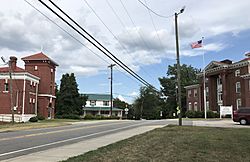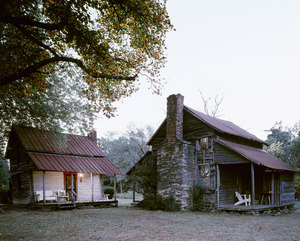Wentworth, North Carolina facts for kids
Quick facts for kids
Wentworth, North Carolina
|
||
|---|---|---|

Center of Wentworth, with the former jail at left and the former county courthouse at right
|
||
|
||

Location of Wentworth, North Carolina
|
||
| Country | United States | |
| State | North Carolina | |
| County | Rockingham | |
| Named for | Charles Watson-Wentworth, 2nd Marquess of Rockingham | |
| Area | ||
| • Total | 14.26 sq mi (36.93 km2) | |
| • Land | 14.19 sq mi (36.76 km2) | |
| • Water | 0.07 sq mi (0.17 km2) | |
| Elevation | 883 ft (269 m) | |
| Population
(2020)
|
||
| • Total | 2,662 | |
| • Density | 187.57/sq mi (72.42/km2) | |
| Time zone | UTC-5 (Eastern (EST)) | |
| • Summer (DST) | UTC-4 (EDT) | |
| ZIP code |
27375
|
|
| Area code(s) | 336 | |
| FIPS code | 37-71900 | |
| GNIS feature ID | 2406858 | |
Wentworth is a town located in Rockingham County, North Carolina, in the United States. It is the main town where the county government is located, also known as the county seat.
In 2020, about 2,646 people lived in Wentworth. The town is part of a larger area called the Piedmont Triad, which includes the cities of Greensboro and High Point.
On May 6, 2022, a strong tornado hit Wentworth. This storm caused damage to trees and homes. It also blocked roads before moving away from the area.
Contents
About Wentworth's Location
Wentworth covers a total area of about 14.4 square miles (37 square kilometers). Most of this area is land, about 14.3 square miles (37 square kilometers). A very small part, about 0.1 square miles (0.26 square kilometers), is water.
People Living in Wentworth
| Historical population | |||
|---|---|---|---|
| Census | Pop. | %± | |
| 2000 | 2,779 | — | |
| 2010 | 2,807 | 1.0% | |
| 2020 | 2,646 | −5.7% | |
| 2021 (est.) | 2,657 | −5.3% | |
| U.S. Decennial Census | |||
Population in 2020
According to the 2020 United States census, there were 2,662 people living in Wentworth. These people made up 953 households and 691 families.
The town's population includes people from different backgrounds:
| Group | Number | Percentage |
|---|---|---|
| White (not Hispanic) | 2,113 | 79.38% |
| Black or African American (not Hispanic) | 317 | 11.91% |
| Native American | 9 | 0.34% |
| Asian | 14 | 0.53% |
| Other/Mixed | 84 | 3.16% |
| Hispanic or Latino | 125 | 4.7% |
Wentworth's History
Wentworth was first started in 1787 and was called "Rockingham Courthouse." This makes it the oldest settlement in Rockingham County. A post office opened there in 1794. The town was officially named Wentworth in 1798.
Both the town of Wentworth and Rockingham County were named after Charles Watson-Wentworth, who was the Marquis of Rockingham. He served as the Prime Minister of the United Kingdom twice and supported the American colonies becoming independent.
In the 1990s, Wentworth faced a challenge. A nearby town, Reidsville, wanted to expand and take over parts of Wentworth. However, the people of Wentworth worked together to stop this from happening. In 1998, the state government allowed Wentworth to keep its original town status from 1798. This meant Wentworth could remain its own separate town. Before this, Wentworth was the smallest county seat in North Carolina.
Several historic places in Wentworth are listed on the National Register of Historic Places. These include the Dead Timber Ford Sluices, Eagle Falls Sluice, Rockingham County Courthouse, Wentworth Methodist Episcopal Church and Cemetery, and Wright Tavern.
The Rockingham County Courthouse
The first court meeting for Rockingham County happened in 1786 at Eagle Falls. In 1787, a courthouse was built in the center of the county, and the area became known as Rockingham Courthouse. In 1798, the state officially named this county seat Wentworth.
The first courthouse was replaced by a brick building in 1824. This building was later updated in the 1880s. In 1906, a big fire destroyed the old courthouse. A new one was built in 1907, designed by a famous architect named Frank Pierce Milburn. This new courthouse was made mostly of bricks and had two round pillars, which became a symbol of Wentworth.
Over the years, more parts were added to the courthouse in the 1930s, 1960s, and 1970s. In 1982, former Vice President Walter Mondale gave a speech there.
In May 2011, a brand new courthouse, called the "Rockingham County Justice Center," opened about a mile east of the old one. This modern building cost a lot of money to build. It holds both the county court and law enforcement services.
The old 1907 courthouse, which is a historic site, now serves as the Museum & Archives of Rockingham County (the MARC). It is the historical museum for the county.
Schools in Wentworth
Wentworth has several schools for students of different ages:
- [Wentworth Elementary School]
- [Rockingham County Middle School]
- [Rockingham County High School]
- [Rockingham County Early College High School]
- [Rockingham Community College] (for college students)
Famous People from Wentworth
Many notable people have come from Wentworth or lived there:
- Robert P. Dick (1823–1898), a lawyer and judge.
- Christopher Knight (born around 1973), a blogger and filmmaker.
- Dalton L. McMichael (1914–2001), a leader in the textile industry and a generous giver.
- John Motley Morehead (1796–1866), a lawyer and politician who became the Governor of North Carolina.
- David Settle Reid (1813–1891), a politician who also served as Governor of North Carolina.
- James W. Reid (1849–1902), a politician who was a U.S. Congressman.
- Thomas Settle (1789–1857), a politician and U.S. Congressman.
- Thomas Settle (1865–1919), another politician and U.S. Congressman.
- John W. Stephens (1834–1870), a politician who served in the North Carolina Senate.
Images for kids
See also
 In Spanish: Wentworth para niños
In Spanish: Wentworth para niños






